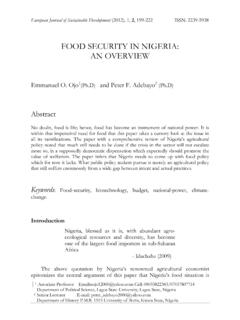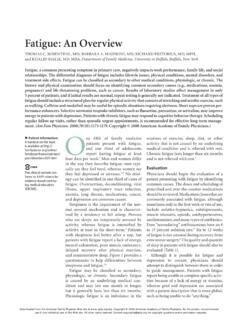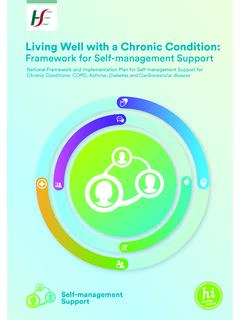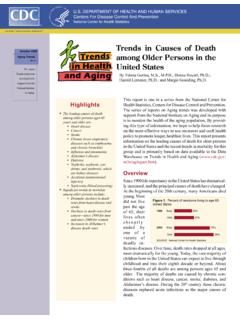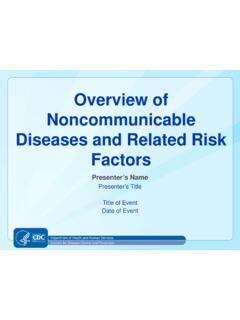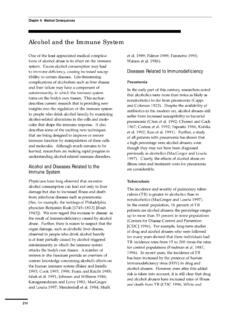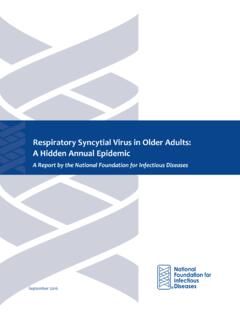Transcription of Epidemiology Key Terms and Core Concepts
1 1 Epidemiology Key Terms and Core ConceptsEpidemiology:The study of the distribution anddeterminants of health-related states in specifiedpopulations, and the application of this study to controlhealth term Epidemiology can be best understood byexamining the key words within its definition. Study: Epidemiology is the basic science of public health. It is a highly quantitative discipline based on principles of statistics and research Key Terms and Core Concepts Distribution:Epidemiologists study the distribution of frequencies and patterns of health events within groups in a population. Using descriptive Epidemiology , epidemiologists characterize health events in Terms of time, place, and person. Determinants:Epidemiologists search for causes or factors that are associated with increased risk or probability of disease . 2 Epidemiology Key Terms and Core Concepts Health-Related States:Early epidemiological study focused solely on infectious diseases.
2 Today Epidemiology studies a variety of health-related events, which includes chronic disease , environmental problems, behavioral problems, and injuries, in addition to infectious disease . Populations: Epidemiology studies groups of people rather than with Key Terms and Core Concepts Control: Epidemiology is used in two ways: 1) As an analytical tool for studying diseases and their determinants, and 2) To guide public health decision-making by developing and evaluating interventions that control and prevent health is a scientific method of Key Terms and Core ConceptsExamples of the types of community health problemsinvestigated by epidemiologists include: A measles outbreak on a small college campus A global influenza pandemic An increase in homicide in a community A national surge in violence An increase in the number of cancer cases3 Epidemiology Key Terms and Core ConceptsEpidemiologists answer questions, such as: Who is sick?
3 What are their symptoms? When did they get sick? Where were they exposed to the illness?Two Types of Epidemiological Studies when epidemiologists have control over the circumstances from the start. Vaccine efficacy trials are good examples of experimental studies because investigators control who gets the vaccine and who does not. when epidemiologists do not have control over the circumstances. Outbreak investigations are usually conducted to support observational studies. Observational studies can be designed in two ways: Descriptive study design Analytical study designDescriptive Study DesignDefined:A type of observational epidemiologic study thathas no predetermined hypothesis. A descriptive studysimply describes what exists in a population by person,place, or time variables (Oleckno, 2002). Descriptive studies are useful in demonstrating trends and generating hypotheses about disease Study DesignExamples: Why does disease occurrence vary with age?
4 Why are there health disparities between different socioeconomic levels of the population?The epidemiologist collects information to characterize andsummarize the health event or Study DesignAsks:Who? Where? When?Three main elements of descriptive Epidemiology :1. Person 2. Place 3. Time Analytical Study DesignDefined:A type of observational epidemiological studywhere epidemiologists make inferences based on the datathey collect. These inferences are the bases forhypotheses, which must be tested using one of twoanalytical study designs. Epidemiologists rely on comparisons between groups todetermine what role various risk factors had in causing Study DesignAsks:How? Why?Examples: Did the chicken salad at the company picnic cause the Salmonella outbreak? Does cigarette smoke cause lung cancer? Are alcohol use and motor vehicle crashes related?Analytical Study DesignTwo Types of Analytical Study Designs:1.
5 Cohort study design2. Case-control study designIn analytical study designs, the epidemiologist is attemptingto discover the relationship between an exposure or riskfactor and a health Study DesignDefined:A designated group of individuals who arefollowed or traced over a period or time (Last, 2001).Step 1:The study population is selected according toexposure status, regardless of whether they have thedisease or health outcome being 2:The exposed group s development rate of thedisease (study outcome) is compared with the nonexposed group s rate of development of the disease (studyoutcome).6 Cohort Study DesignElements: Often referred to as prospective studies because a cohort study follows the population forward in time from suspected cause to effect. Used to investigate outbreaks in small, well-defined : Dividing a group of people on the basis of smoking status and then following them for 20 years to see if they develop lung Study DesignRequires a large number of subjects, if the disease is directly calculate the incidence of disease for each of the exposure groupsCostly in timeCan examine multiple outcomes for a single exposureFollows study groups forward in time which may result in logistical problems and subjects dropping out of studyIs logical; sequence follows the exposure to the development of the diseaseCostly in resourcesAre very useful in examining rare exposuresDisadvantagesAdvantagesCase-Con trol Study Design Defined:A group of individuals with an event or conditionof interest (case-subject) is identified and compared toindividuals without the event or condition of interest(controls).
6 7 Case-Control Study Design Step 1:Participants are selected on the basis of thepresence or absence of the disease or outcome 2:Participants are assigned to one of two groups: People with the health problem (case-subjects) People without the health problem (controls).Step 3:Case-subjects are compared to controls in order todetermine the presence of specific exposures or Study DesignElements: The epidemiologist is working backward from the effect to the suspected cause. These studies are often referred to as retrospective studies since they look back in Study Design Cohort and Case-Control Attempt to answer the how and why questions. Are able to quantify the relationship between an exposure and an outcome. However, a mathematical or quantitative relationship between the two is not enough to establish Study DesignFive criteria must be met to establish a cause-and-effectrelationship: of association or relationship between cause and effect must be of the association must be repeatable in different populations at different cause must precede the explanation must make sense must be a dose-response Transmission TerminologyEpidemic:The occurrence of more cases of a diseasethan would normally be expected in a specific place orgroup of people (population) over a given period of time.
7 Note:To an epidemiologist, outbreak means basically the same thing as epidemic. To the public, however, epidemic is perceived to be more serious than outbreak. For this reason, the term outbreak is often used to avoid public concern and Transmission TerminologyCluster:A group of cases in a specific time and place thatmay or may not be greater than the expected rate. Oftenthe aim of investigating clusters is to determine thebaseline rate of disease for that time and place. Note:The word cluster is sometimes incorrectly used in place of epidemic or outbreak. Endemic:A high baseline or background rate of Transmission TerminologyExposure:Having a certain feature that is being studied. For example, in a study on alcohol consumption, peoplewho drink alcohol are considered the exposed group,while non-drinkers are considered the unexposed group. Note:There is a wide variety of exposure to consider when studying a disease , such as exposure related to lifestyle, behavior, occupation, employment, genetics, diet, and the use of Transmission TerminologyIncidence:The occurrence of new cases of disease thatdevelop in a population over a specific period of time.
8 It isthe frequency with which new disease period:A period of sub-clinical or non-obviouspathologic changes following an exposure. The incubationperiod ends with the onset of Transmission TerminologyLatent period:The interval between disease onset andclinical diagnosis. Morbidity rate:The number of existing or new cases of aparticular disease or condition per 1000 people (Achengrau& Seage, 2003).Mortality rate:The total number of deaths per 100,000people (Achengrau & Seage, 2003). 10 disease Transmission TerminologyPandemic:An epidemic causing illness or death over anextensive area, generally crossing international borders(Oleckno, 2002).Period of communicabilityThe time (days, weeks, months) during which an infectious agentmay be transmitted, directly or indirectly, from an infected personto another person; infected animal to humans; or from an infectedperson to animals or arthropods.
9 Prevalence:The proportion of the total population that isdiseased. It is the frequency of existing Transmission TerminologyProdromal periodThe time during which a disease process has begun but is not yetclinically manifest. Reservoir(of an infectious agent)Any person, animal, arthropod, plant, soil, or substance (orcombination of these) in which an infectious agent normally livesand multiplies, on which it depends primarily for survival, and where itreproduces itself in such manner that it can be transmitted to asusceptible host. Chain of TransmissionDefined:Occurs when an agent is passed from one host toanother, and a suitable mode of spread allows an outbreakto :A chain of transmission must be present inorder to cause an of Transmission: AgentDefined:Any substance that can cause death, disease , orother biological malfunction in humans, animals, plants, orother living organisms.
10 Three types of agents:A. Biological -A bacterium, parasite, or Physical force- Any type of physical force ( ,earthquake, car crash, accidentally dropping an object).C. Chemical- Chemical substances, whether gaseous,liquid, or solid, which can be inhaled, ingested,absorbed, or of Transmission: AgentKey characteristics of agents: Infectivity-The capacity to cause infection in a susceptible host. Pathogenicity -The ability to cause disease in a host. Virulence -The severity of disease that the agent causes in the host. Transmissability -The ease with which the agent can be of Transmission: HostDefined:The person or organism that is susceptible to the effect of an characteristics of hosts: The status of the host is important and is generally classifiable as susceptible, immune, or infected. The host's response to exposure varies widely, from showing no effect to manifesting sub-clinical disease , atypical symptoms, or severe of Transmission: EnvironmentKey characteristics of the environment: Physical Climatologic Biologic Social EconomicChain of TransmissionRequires Four Phases:1.
